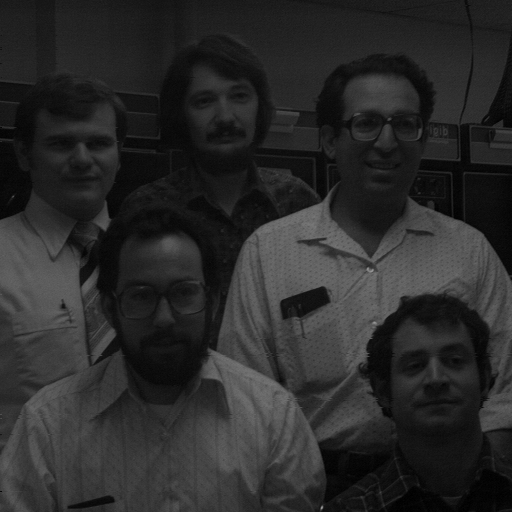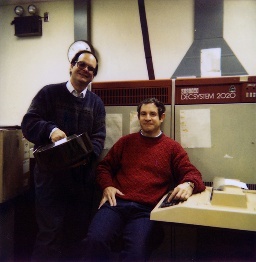...
- Lewis Lipkin: optical microscopy of serial brain sections and macrophage motility measurements with asbestos
- Peter Lemkin: bone marrow smear analysis, 2D gel electrophoresis
- Bruce Shapiro: RNA secondary structure of electron micrographs
- Carl Merril: NIMH/NIH - 2-dimensional (2D) gel electrophoresis, E.coli mutants and macrophages with asbestos
- Jacob Maizel: NICHD/NIH, with Bruce Shapiro - RNA electron microscopy of secondary structure
- Eric Lester: NCI, U. Chicago, and oncology practice - 2D gel electrophoresis on human leukemias
- Steve Aley and Russell Howard: NIAID/NIH - 2D gel electrophoresis of Plasmodium knowlesi clones
- Peter Wirth and Snorri Thorgeirsson: NCI/NIH - 2D gel electrophoresis on liver cell lines
- Peter Sonderegger: NICHD/NIH and U. Zurich - 2D gel electrophoresis of axonal proteins of sensory and motor neurons
| Divpanel | ||||||||||
|---|---|---|---|---|---|---|---|---|---|---|
| ||||||||||
| ||||||||||
| Panel | ||
|---|---|---|
Figure 3. The Digital Equipment Corporation DECsystem-2020 running the TOPS-10 operating system. The system is shown with Bruce Shapiro, holding a removable 180MB "bathtub" size disk pack (on the left), and Peter Lemkin (on the right). It had 512K words, 36-bits/word, 256K word virtual space/user, a very powerful instruction set, and many high-level computer languages, including SAIL (Stanford Artificial Intelligence Language - see wikipedia.org entry on SAIL) , that made implementing complex analysis algorithms much easier than on the PDP8e. SAIL was developed by Dan Swinehart and Bob Sproull of the Stanford AI Lab in 1970. Sproull was at Division of Computer Research and Technology (DCRT) in the early 1970s and introduced the language to DCRT [the precursor of NIH's Center for Information Technology (CIT)]. Over time, we implemented more of the advanced image processing and pattern recognition algorithms in SAIL, using the RTPP as a sophisticated data acquisition and interactive graphics front-end. Later many of these algorithms were rewritten in C and UNIX using X-windows (we rewrote the C/UNIX/X-windows GELLAB-II exploratory analysis system from the SAIL/TOPS-10/RTPP GELLAB-I), and in LISP (StructureLab with a Symbolics Lisp machine and later a Unix Platform) when the DECsystem-10/20 computer lines were phased out in favor of the VAX computer lines. Later still, much of the C code for GELLAB-II was converted and rewritten in Java and used as part of the Open2Dprot project. We will discuss some of these projects later under the section Applications of the RTPP in Biomedical Research. | ||
| Div | ||
| ||
| Div | | |
|
| Div | ||
|---|---|---|
| ||
Figure 3. The Digital Equipment Corporation DECsystem-2020 running the TOPS-10 operating system. The system is shown with Bruce Shapiro, holding a removable 180MB "bathtub" size disk pack (on the left), and Peter Lemkin (on the right). It had 512K words, 36-bits/word, 256K word virtual space/user, a very powerful instruction set, and many high-level computer languages, including SAIL (Stanford Artificial Intelligence Language - see wikipedia.org entry on SAIL) , that made implementing complex analysis algorithms much easier than on the PDP8e. SAIL was developed by Dan Swinehart and Bob Sproull of the Stanford AI Lab in 1970. Sproull was at Division of Computer Research and Technology (DCRT) in the early 1970s and introduced the language to DCRT [the precursor of NIH's Center for Information Technology (CIT)]. Over time, we implemented more of the advanced image processing and pattern recognition algorithms in SAIL, using the RTPP as a sophisticated data acquisition and interactive graphics front-end. Later many of these algorithms were rewritten in C and UNIX using X-windows (we rewrote the C/UNIX/X-windows GELLAB-II exploratory analysis system from the SAIL/TOPS-10/RTPP GELLAB-I), and in LISP (StructureLab with a Symbolics Lisp machine and later a Unix Platform) when the DECsystem-10/20 computer lines were phased out in favor of the VAX computer lines. Later still, much of the C code for GELLAB-II was converted and rewritten in Java and used as part of the Open2Dprot project. We will discuss some of these projects later under the section Applications of the RTPP in Biomedical Research. |
3. The NCI Autoradiograph Grain Counter: Precursor of the RTPP
...





